The following information on outdoor and indoor shooting ranges comes from Section 20 of Shooting by J. Henry FitzGerald. Shooting is also available to purchase in print.
Many successful revolver clubs have started in some one’s cellar. Cellars are usually twelve or thirteen yards long and targets may be procured for the twelve-yard distance. The twelve-yard Standard American target may be used for slow-fire shooting and for those who wish to practice for the twenty or fifty yard ranges. For those who wish to practice for rapid-fire shooting the twelve and one-half yard Colt’s police target may be used for slow, rapid, and timed fire.
The first requirement for all indoor shooting ranges is a suitable backstop, side wall, and other protectors. Captain Arthur D. Caswell, Anoka, Minnesota, will explain this protection in his article, “The Indoor Revolver Gallery,” in the back of this section. Captain Caswell furnishes the best equipment obtainable for revolver and rifle ranges and is an expert in the installation of safe ranges.
If the indoor shooting range can be so planned as to have the floor timbers run across the line of fire it will eliminate steel plate overhead except the first ten feet at the firing point. If the firearms are carefully handled one of the Caswell Portable Galleries can be used, with no other protection.
The favorite arms for cellar ranges are: The .22 single shot pistol, .22 automatic pistol, .22 Official Police, and .22 Officer’s Model. Due to noise and annoyance to the neighbors the .22 caliber arms are universally used in cellar ranges. Many enjoyable evenings may be spent in a range of this kind and at the present time so many sportsmen are fitting their basements into a den that I believe they would find a little range placed in one corner a very welcome and enjoyable addition.
Mr. J. Allen Van Wie of Troy, New York, showed me a round bullet catcher twelve inches in diameter and after seeing him perform with it at a distance of thirteen yards I was satisfied that he had taken all necessary precautions against wild shots. I would not recommend this size of backstop for all dens, but I have seen many that were perfectly safe for the average revolver enthusiast. I have visited many cellar ranges and have yet to be told that the range was taken down because no one cared to use it.
If the indoor shooting range is to be used by police officers, guards, and bank clerks, they will demand practical experience in rapid fire work and here the Langrish Limbless target and Colt Silhouette target can be used. As a money-getter for a club the Fitz Luck target is a wonder. Turkeys, chickens, or other merchandise may be shot for with a big profit and every one has an even chance to win no matter what his shooting experience has been. The .22 Luck target is more popular than the .38 target as it can be used for high and low count to win. The target for .38 caliber or larger arms should be shot at twenty yards if low and high scores are to be counted for a good shot may pick the low numbers at the edge of target at fifteen yards or less. The .22 target may be used at any distance between ten and twenty-five yards.
We have also the matter of telescopes. It is desirable in every range for the shooter to see where his shots are going and thereby make corrections. A small stand may be purchased to hold the scope in line with the target or the stand may be attached to the wall. A twenty or twenty-five power scope is recommended for this work. A telescope is very necessary at all distances over twelve yards as the shooter should check up on every shot fired at slow fire, first naming the shot to himself and then checking with the scope. Great care must be taken not to look through the scope for a longer period than is necessary, for the eyes will become distorted and blurred, which will make the sights and bull’s-eye indistinct. Three to five seconds will do very little harm, but three to five minutes will be very liable to cause the above result.
In some ranges the very serious trouble is ventilation. After a few shots the smoke will so fill the range that neither sights nor target may be seen clearly. In many cases windows covered by baffle plate may be opened to clear the range and when windows are not available a blower may be installed connecting with the outside or with a chimney. If a ventilator is to be installed it should be placed, if possible, about eight feet ahead of the firing line. This, however, is seldom necessary for I have visited several large ranges where a great deal of shooting was indulged in and the only ventilation was windows, doors, or a connection with a chimney.
Range rules and Safety rules displayed in the range will assist both new and old members. I am forever preaching safety and this is due to the many accidents I have seen on different ranges and the careless handling of firearms which might have resulted in an accident. For instance, twenty-five years ago at Walnut Hill Range about twenty-five members stood around talking when one of the men raised his pistol, which he was holding, and said: “See that knot in the board; if this pistol was loaded I would hit it plumb center.” He aimed and pulled the trigger and did just what he said he would do, but he did not know when he aimed at the knot that the pistol was loaded. Another near accident was at the Boston Rifle and Revolver Club range. I was teaching a lady to shoot and one of my instructions was to lay down the revolver on the shelf every time she left the firing point or when I was changing targets. She asked me to change targets and I stepped up to the firing point. I could not see the revolver and looked in her direction. The revolver was aimed at my hip and cocked, not intentionally, but just through carelessness. I jumped backward just in time. The bullet went through coat and vest, flattened on my belt buckle and out through the coat and vest on the other side. At another time I was sitting at the range desk when one of the men at the firing point turned to tell me that he had a misfire. As he turned with the gun in his hand the explosion occurred and the bullet put two holes in a new hat I was wearing. In addition to these close shaves I have had one bullet hole in each leg, part of a little finger shot away and one shot through my face; therefore, I shall continue to talk on safety.
I have suggested that the police be urged to join the revolver club as this arrangement creates a friendship between citizens and police that is lasting and very beneficial to both parties. In this manner the police have a fair idea as to the citizens who should be eligible for a permit to carry arms, and the citizens have a clearer idea of the many trials and tribulations of the policeman.
Outdoor Ranges
In connection with the indoor shooting ranges every club should have an outdoor range. This need not be an elaborate affair for some piece of ground can be found with a natural backstop adaptable to the needs of a revolver club. As fifty yards is the greatest distance that a revolver or pistol is used, unless small bore and long distance rifle shooting are to be used on the same range, a suitable place can be found which may be reached from any small city or town. Of course the larger the town the more miles to be covered, unless some military range can be used.
The natural backstop should be at least thirty to fifty feet high and even at this height care must be taken that stray shots do not get over the top as the revolver and pistols at this angle would carry from twelve to sixteen hundred yards. With a natural backstop the only thing necessary is two uprights and cross pieces at proper distance to hold the targets at shoulder height. If possible a table or bench should be in front of the shooters at both twenty-five and fifty yards to eliminate accidents and to lay the outfit upon. Some of the most enjoyable days of my shooting career have been spent on just such a range.
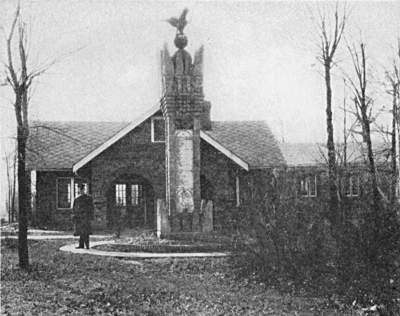
It is best for those who desire to enter in matches on other ranges to choose a range that is not sheltered, as it is those who are accustomed to shooting in the wind and to the light changes who will give the best account of themselves when they go to other ranges.
If a range can be found with pleasant surroundings the entire family would enjoy it as much as the confirmed gun-bug. The lunch basket, the range, the family,—what could be finer?
For the little club which wants a more elaborate and up-to-date range, pits may be dug and target frames erected, which means that the pit must be either lined with heavy planks or, better still, made from cement at least two feet thick and banked with earth and cement so that no bullet can possibly penetrate to the pit. On ranges where there is no range master stationed, it is well to equip pits with heavy waterproof covers if possible. Make pits roomy enough for extra targets, target frames, pasters, paste, spotters, etc., setting target frames at rear of pit; in this way the markers can see where the shots strike without pulling down the targets.
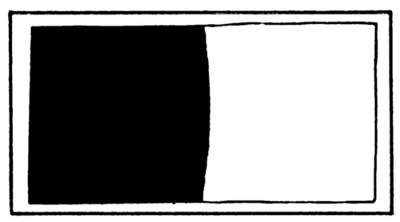
A range house is a welcome addition to any range, preferably with a porch and a few chairs and tables. A stove and dishes may be added, as hot coffee and lunches will be very acceptable to the members and such lunches may be paid for out of the entry fees. Heavy shutters and a heavy door, with a still heavier lock, should be added in some localities as a shooting house is always the special mark of the small boys. Thus we find we have a complete range with practically no outlay of money.
The Toledo (Ohio) Police Range, which is, I believe, the peer of all outdoor revolver ranges, was made possible through the untiring efforts of Lieutenant Charles Hennessy, Inspector Delehanty, and officials of the Toledo Police Department. It is one of the finest revolver ranges that I have ever visited. As will be noted in the photographs the natural backstop was missing and a heavy cement wall was used instead. I take great pleasure in showing views of this range as I feel that it will stimulate interest in other clubs and police departments throughout the country. This range was planned and built entirely by members of the department.
While in nearly all cases a safe range may be found within a reasonable distance, the occasion may arise to install a range where artificial safety devices are to be used: At firing line, a partition or wall seven feet high with stalls three feet wide for each shooter, the partition or wall to be filled with fine sand fifteen inches thick; a window through this and steel plate in the form of a tube small enough at the end next to the target to deflect all bullets that would not hit some part of the target or backstop, but it is rarely necessary to take this trouble. It is advisable to have one firing line for all distances whether shooting at twenty-five or fifty yards and two target frames or pits for each distance; this is to avoid accidents and for the benefit of the spectators.
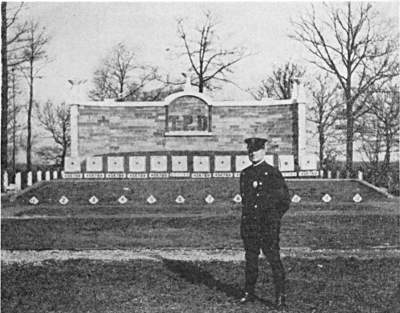
Telescopes and stands are necessary and also a few folding chairs. Many ranges pleasantly situated call for a week-end camping party which the family can enjoy.
A site must be chosen that is suitable for both fifty and twenty-five yard ranges, for the man who wishes to make good scores at all the ranges must practice at all ranges and with the different arms required for the various matches. The man who only shoots twenty and twenty-five yards will be lost the first time he enters a fifty-yard match without practice, for his score will not be satisfactory. If all distances are to be shot with one revolver, it is recommended that it be accurately targeted for fifty yards and it will then, with a slight change in holding, be correct for the other ranges.
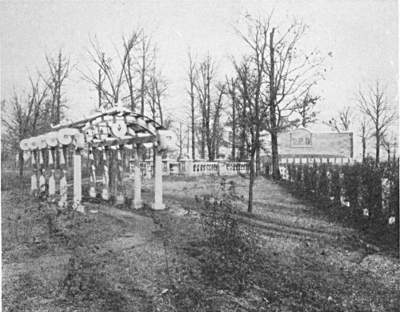
Fitz Range Rules for Safe Target Practice
1. NEVER handle, point, or look over the sights of any firearms handed to you without first opening the arm to be sure it is NOT loaded. You are being tried and your standing with other shooters depends on this one action.
2. NEVER take an automatic pistol or revolver out of your pocket or holster until you are at the firing line. If you wish to unload your revolver or pistol before it is your turn to shoot, step up to the firing line, unload, and show the arm to the instructor swinging cylinder out. If an automatic pistol is used, draw slide back, fasten it, and remove magazine.
3. NEVER glance into your pistol or revolver hurriedly and decide it is NOT LOADED. LOOK ONCE to see that it is NOT LOADED—LOOK AGAIN to be sure you haven’t made a mistake.
4. NEVER load or cock a pistol or revolver in any range unless you are at the FIRING POINT and FACING the target.
5. NEVER lower a pistol or revolver so that it will point toward any part of the body. This is liable to happen when you are resting and between shots. When resting, lay the pistol or revolver on the table or bench if one is in front of you; if not, rest it in the other hand ALWAYS pointing toward the target.
6. NEVER turn around and talk to persons behind you when at the firing point without first laying your pistol or revolver on the table.
7. NEVER leave the firing point with your AUTOMATIC until you have drawn the slide back and fastened it, leaving pistol OPEN. Remove the magazine from your pistol.
8. NEVER leave the firing point with a revolver without swinging the cylinder out or removing same from pistol.
9. NEVER point the pistol or revolver upward or backward over the shoulder; by so doing you are making all parts of the range unsafe.
10. NEVER, in case of misfire, open the pistol or revolver for at least twenty seconds and keep it pointed toward the target.
11. NEVER try fancy shooting or quick-draw work in the presence of your friends until you have first tried it in private and know what you can do.
12. NEVER point a pistol or revolver at any one or anything you do not want to shoot.
13. NEVER fire a shot until you know your sights are in line with the target. You are only wasting your time and ammunition if you do not take pains with every shot.
14. NEVER talk to a shooter when he is at the firing point; wait until he has finished and steps away.
The Indoor Revolver Gallery
By Captain Arthur D. Caswell
There are many things to consider in the construction of even the most simple type of indoor shooting range; perhaps the most important item to be considered is its safety. The revolver, due to its short barrel and great power, must be handled with extreme care at all times. We cannot expect the novice to be able to manipulate the revolver as safely as the well-schooled expert, but he must be taught at some time and we cannot expect him to confine his practice entirely to an empty revolver. It is our duty, therefore, to see that he is fully instructed in the use, care, and manipulation of the revolver, and it is further our duty to see that our indoor shooting ranges are so constructed as to insure the maximum amount of practical safety. In addition, it is always wise to have an experienced range officer on duty at the gallery at all times to see that safety regulations are strictly adhered to.
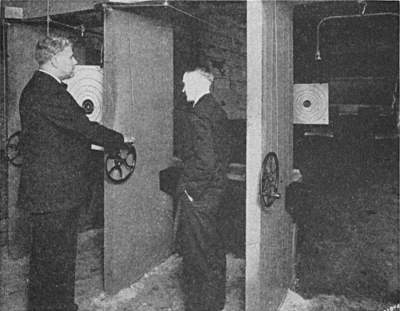
One of the first things to consider is the adaptability of the room which has been chosen for the indoor shooting range. Are the side walls, ceilings, and floors of the proper material to stop or deflect a bullet? If not, we must make them so. Usually the cheapest method of making the gallery bullet-proof is by the installation of steel plates, if the building is of wood construction. If the gallery is to be planned in conjunction with an entirely new structure it is advisable to see that all walls, floors, and ceilings are made up of concrete or, in case of the walls, only brick may be used. In no case should tile be used, as it will not stop even the .22 caliber long rifle bullet. For side wall and ceiling protection a light steel plate from 1/8 inch to 3/16 inch is normally used. Plates of this thickness will not withstand continual firing of the heavy caliber cartridges and for the main bullet stops it is customary to use not less than 1/4 inch steel plates and in many cases it is preferable to use either the 5/16 inch or 3/8 inch thickness. For heavy caliber firing these should be set at an angle of 45° with the floor, while if only the .22 caliber cartridge is to be used the angle could be 60°.
In many cases we find that the only room available for the revolver gallery is a very narrow one, which we find is bad for heavy caliber firing for reason of the accompanying sharp report of the revolver. We can eliminate the objectionable report of the revolver if we can afford to install sheets of sound-proofing celotex or other material which will absorb the sound. Usually this is a very expensive item and oftentimes the lack of sufficient funds places this material beyond the reach of the average club. To offset this disadvantage the shooters may use for the main part .22 caliber revolvers or reduced charges in their service revolvers.
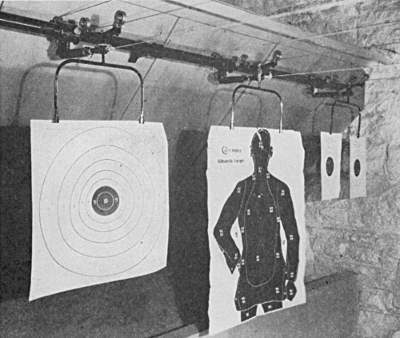
Where we find concrete or steel columns close to the firing points which would deflect a stray bullet back toward the shooter, it is a good idea to place a steel plate in front of the column or beam in such a manner as to deflect the bullet fragments toward the butts. In any case where it would be impractical to use the steel plate, oftentimes it is more simple to cover same with a 2-inch plank. These items should be considered because beginners are likely to do many things which will endanger other shooters as well as themselves, and a little careful thought may oftentimes save a serious or, at the least, an unpleasant accident.
The space allotted for the shooter’s firing position should not be less than three feet and to enable a coach sufficient room we need at least three and one-half feet. Even four feet is none too much space for the shooter’s position, and where this space is available it would be wise to use it. We find many types of firing points in different parts of the country. In some sections the open type is used, which is usually safe enough if skilled shooters only are to use the gallery. For police galleries where we are likely to have many new men firing at one time the closed or protected type of firing point is the most popular. Usually the closed type firing point or booth is made up of steel plates on either side covered with wood to further prevent bullet fragments from accidental shots from injuring the shooters within the booth or within the adjoining one. The steel plate used for this purpose is usually two to two and one-half feet wide by seven feet high and 3/16 inch thick. The wood covering may be ordinary dressed and matched lumber or even a good grade of flooring depending on the amount of money which is to be spent for this part of the gallery.
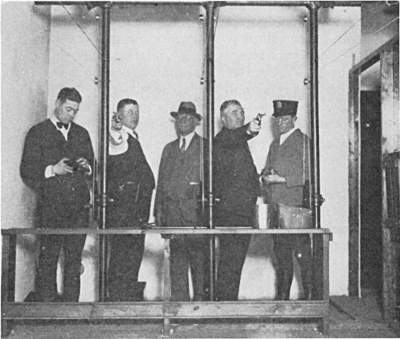
The present standard revolver galleries in use today are the 10, 12, 12 1/2, 15, 20, 25 and 50 yard ranges. The 50-yard gallery is usually out of the question, as the cost of a gallery of this length is not warranted from the practical standpoint. The 25-yard gallery is fast becoming a popular range for police and military shooters. The entire army qualification may be fired indoors in a revolver gallery of this length, and the police departments are able to start the new men out at the 12 1/2-yard or mid-range with the preliminary firing, later changing to the 25-yard range, which is normally considered sufficient for any practical police firing. The 25-yard range enables the police officers to train at home for the police matches held at the National Matches each year, using the identical target and range. The 25-yard gallery has the advantage of being correct for the 75-foot rifle firing and, if the carrier is of the proper type, rifle and revolver firing may be conducted conveniently in the same gallery. The 20-yard range is the one adopted by the United States Revolver Association and all of their indoor matches must be fired at this distance. The target adapted to this range is of such size and proportions as to render high scores possible only by the expert and the firing is usually of a different type than that normally approved by police and military men.
In some galleries the mid-range firing is conducted at a point in front of the long range firing line and either a movable bench is carried forward or else secondary booths are installed and the carriers are operated by reaching overhead and pulling the puller cord instead of the hand wheel. If this arrangement is used strict discipline is necessary at all times to insure that no one handles a firearm of any nature in rear of the shooters. Again it is questionable whether this arrangement insures sufficient safety when many new men are to be instructed. In no case should any one ever be allowed to snap a firearm in rear of the firing point of any gallery or range, as many serious accidents have resulted from this practice.
Usually the first part of the gallery to be installed should be the bullet stop as all measurements are more or less vague until it is actually in place. There are many ways of supporting the steel plates of the main bullet stop and possibly the simplest method, where the room is not too wide, is by the use of an angle iron supported at each side wall. The plates may then be laid on top, lapped and bolted, provided the span between the bottom support and the angle iron at the top is not too great. If this span is too great or additional stiffness is desired steel tee irons may be placed from the floor to the angle iron, then the plates are laid on the tee irons and bolted securely to same. The bolts should be 5/16 inch and spaced at about eighteen-inch centers. The use of an angle iron at the top further prevents bullet fragments from chipping the ceiling if properly placed.
In many cases club members will prefer to use wood beams instead of steel members for reason that they are more easily procured and perhaps more easily installed due to the usual lack of steel working tools. In any case it is desirable to use plenty of bolts and supports, as the more stiffness the plates have the longer life they will have as steel deflecting plates. Remember that for heavy caliber revolver firing the plates should not be less than 1/4 inch thick and preferably 5/16 inch or 3/8 inch thick and set at an angle of 45° with the floor. At each side for at least a distance of fifteen inches down from the deflecting plates a light plate should be installed of about 3/16 inch steel to prevent wear of the side walls by the fragments of bullets.
Oftentimes the steel plates may be supported from the rear wall by rods connected to the top of the steel plates and either securely fastened into the rear wall or inserted entirely through the wall and anchored to metal or wood braces on the backside of the wall. In very narrow galleries the plates have been supported by pieces of 1/2-inch pipe securely inserted in the side walls and continuing from the bottom to the top of the plates at intervals of about eighteen inches. The pipes project into the gallery only a couple of inches, which is sufficient to support the plates. When this method is used the plate is usually about 3/8 inch thick to give the proper rigidity.
The height of the bullet stops usually varies considerably but it is advisable to have them start at the floor and continue to a height of at least seven feet and if funds are available it is nice to have the plates continue to the ceiling. In many galleries we find that the bullet stop is completely covered with wood or beaver-board. Usually the use of wood is not necessary and is rather expensive to keep in proper condition, so we find that beaver-board will prevent the fragments of bullets from being thrown forward, at the same time giving a background which may easily be painted to suit desires and it is also cheaply and easily replaced.
At the base of the bullet stop it is imperative that we have a good bed of clean screened sand to catch the bullet fragments, preventing them from being thrown back at the shooters. This bed of sand should be at least a foot deep and can be even deeper to advantage. In some galleries we find that special bullet-catcher chambers are in use, but the cost of these plates bent to catch the fragments is so great that it renders same prohibitive. The simplest method to safely catch the fragments is by the use of sand and it is doubtful whether the cost of the bullet-catcher chambers are warranted for large, permanent galleries.
For the modern gallery we have come to a point where we consider the target carrier an absolute necessity for safety and efficiency. It is one of the best guards against accidents and furnishes a convenient means of further speeding up the fire, thereby enabling a greater number of shooters to fire a given number of shots in a limited time. When we consider a target carrier system we should consider one which is easily operated, simple, and of extremely durable construction. The use of a carrier which does not work freely oftentimes upsets the shooter to such a degree that it impairs his scores. It should be simple, otherwise there is a possibility of its becoming easily placed out of order either by improper operation or by superfluous parts. It should be durable especially when the heavy caliber revolver is used, otherwise a poorly directed shot may easily place the carrier out of order.
The carrier should also eliminate any objectionable vibration when the target is in the firing position and should not be affected by the movement of other carriers or it will prevent the other shooters from bringing in their targets from time to time for inspection or replacement. The carrier should also be adaptable to any type of indoor target and should be so designed as to be practicable for all positions of rifle and pistol shooting without the use of a shooting table. An indoor shooting range should not be limited to the sole use of either the rifle or revolver but should be adaptable to the use of both types of arms.
Oftentimes considerable trouble is experienced in properly stretching the trolley wire for the target carrier track. In the past the tension of the wire was applied by the use of eye-bolts. This method, while practicable under some conditions, usually was not entirely satisfactory for reason that the wire could not be stretched sufficiently taut. Really the most satisfactory method of stretching the trolley wire is by the use of the telephone man’s “Come-along” or a device consisting of two slack-off blocks, two tackle blocks, and about twenty feet of 3/8-inch rope. Usually the “Come-along” will have to be borrowed from the local telephone company, as it is not carried as stock in the average electric shop or hardware store.
When the “Come-along” is used to stretch wire the eye-bolts are only taken up sufficiently to insure that they will properly stand the tension exerted by the wire. This will later permit a means of tightening the wire after the gallery has been in use some time. It is apparent that the uprights and carrier supports should be installed in a most rigid manner to prevent unnecessary movement, which results in making the trolley wire slack.
We find that the target illumination is another stumbling block and is a problem in itself. Some shooters feel that they must have an extremely intense light, while others can shoot under a very mild light condition. It is normally well not to have the target illumination too intense as it causes target glare and also a strain on the shooter’s eyesight, which results in headaches and poor scores, especially if many shots are to be fired. It is practically impossible to please the desires of every shooter and we must therefore work along compromising lines.
In some sections of the country the large enclosed type of flood-lighting fixture, using either the 500 or 1000 watt lamp, has proven satisfactory. With this fixture it is imperative that the lens be of the stippled or diffusing type as the clear glass lens gives a very unsatisfactory type of target illumination. Target illumination should be ample, yet it should be mild in quality, as a sharp light is very tiresome to the eyes.
Recently the window type of floodlight has been used with satisfactory results. This is an inexpensive type of fixture using a 200 or 300 watt lamp. The fixture is of the open type and does not use a glass lens. It is also equipped with a strap iron bracket which is adjustable, making it very simple to install by the novice.
In conjunction with the target illumination we find that the painting of the bullet-stop and near-by background has considerable bearing on the uniformity and the quality of the light. In rifle galleries and in some revolver galleries it has been found that a soft, white background adds considerably to the proper target illumination. Usually a little yellow is mixed with the white paint and it is further imperative the paint used be a flat paint; a gloss paint will in practically every case give a most unsatisfactory result. In police galleries we often find that a flat black paint is favored for reason that it assists the shooter to concentrate on the contrasting white target, which means that he will be able to deliver quick fire with greater speed. Oftentimes, however, a white target against a black background will present a glaring object to aim at due to the great contrast.
Every revolver gallery should have a bench or shelf just in front of the firing point so that the shooter may place his cartridges in a convenient location and may also rest his revolver on it when resting between the firing. It is also desirable to have a container at each position in order that the empty cartridge cases may be placed therein immediately after firing each string. This will help to keep the gallery clean and neat, which further attracts the right class of shooters.
In general the gallery should be as convenient and attractive as possible and so arranged as to present a comfortable and orderly appearance at all times. There should be no obscure corners for the accumulation of dirt; in fact, every possible effort should be made to see that the gallery is spotlessly clean. An untidy gallery is a sad reflection on the range officer and the organization to which the gallery belongs. Clean, orderly galleries inspire the right kind of efficiency and discipline, which is a good start towards a wide-awake organization.
If possible arrangements should be made for a cleaning bench and shelves for target and ammunition storage. If possible it is also a nice thing to have a room for reading and lounging purposes. This room should be handy to the gallery, but not so arranged as to interfere with the men firing. In this room cards showing the range rules, grip and sighting charts, and other data pertaining to the development of marksmanship, should be displayed on the walls in such a manner as to enable the men waiting for their turn to fire to refresh their memories on these important items. Oftentimes high score targets are displayed to further encourage the right sort of shooting. After the gallery is an actual reality every effort should be made to keep it in the best possible condition. Do not permit any careless firing or improper handling of firearms and last, but not the least, make full use of your gallery. Keep it in use as much as possible and remember that it is a means of permitting revolver practice under the most favorable conditions, day or night, rain or shine.
